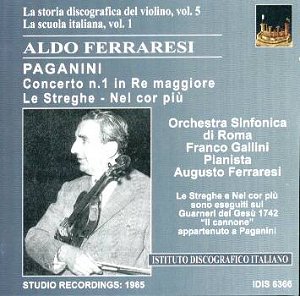Born in 1902 Aldo Ferraresi was heard by the visiting
Czech violinists Vaša Prihoda and Jan Kubelik who strongly suggested
he go to Brussels to study with Eugène Ysaye, a course of action
he duly followed. Whilst he didn’t record prolifically, there are some
78s to his name and a few LPs. These are mainly of genre pieces for
Italian HMV – QDLP6048 and QCLP12025 are the ones to look out for -
and others for Odeon and Storia della Musica. To the vexing question
as to what happened to the Italian violin school between Arrigo Serato
(b. 1877) and Salvatore Accardo (b. 1941) Ferraresi adds a new dimension.
Certainly Gioconda de Vito (b. 1907 and thus Ferraresi’s junior) made
her significant mark, not least in recordings. And Pina Carmirelli (b.
1914), leader of the Boccherini Quartet, was another prominent figure
in Italian musical life but it’s true to say that post-Serato, indeed
from significantly before, the Italian school slumbered for a while.
And yet, like many another talented musician, Ferraresi’s
career was somewhat circumscribed – principally as leader in the Orchestra
of San Remo and the San Carlo theatre, or as first violin in the San
Carlo Quartet. His numerous concerto engagements elevated him to the
status, I suppose, of leader-cum-soloist, though the list of conductors
with whom he worked was prodigious enough – Barbirolli, Knappertsbusch,
Munch, Cluytens, Celibidache and Rodzinski amongst them. His brother,
Cesare, some of whose trio recordings on the Aura label I have recently
reviewed, was another splendid violinist, though not quite on a par
with his older brother, and was a chamber player and teacher of distinction.
The brothers also excelled at the art of Tango playing and Aldo once
poached a small fortune in his early days with idiomatic performances.
Again like many players he plied his trade from the bottom up – the
list of violinists who played in café or so-called Gypsy bands
is a long and distinguished one.
Here he performs his beloved Paganini. Splendid playing
in many ways but not quite enough to lift him to the exalted level.
The recordings, made for Italian radio in 1965 are quite raw and they
have a rather cavernous acoustic, which does little but to diffuse the
focus of sound. The strings also emerge rather glassily from all this
but persist and we can admire Ferraresi’s often febrile playing. Yes,
he can be fallible at the top of his register – but he was an unusually
humble musician, the notes telling us he once insisted a recording of
his be released only on condition that his wrong notes were left intact.
As he’s so forwardly recorded we have plenty of opportunity to survey
his musicianship – and this was the man, after all, who was approached
to succeed Efrem Zimbalist as head of violin at Curtis (a position he
declined). He has a strong technique, a vibrato under control, a degree
of lyric intensity especially in his lower two strings, with an astute
ear for emotive finger position changes if at times guilty, in the first
movement especially, of some rather self-serving theatricality. Something
happens to the balance in the cadenza – he leapt out of my speakers
like a tiger – so maybe the recording level was notched up a little
by studio engineers; no need really as he plays quite well enough as
it is. He continues the good work in the second movement, including
some gulped notes and more intensifying moments, though his emotive
playing isn’t really quite consistent enough to carry the weight of
the espressivo with optimum depth. His bowing is frequently magnificent
in a finale notable for some not quite immaculate left hand and a spirited
and humorous conclusion.
In Le Streghe his son, Augusto, accompanies
him. There is much spirited and committed playing here once again though
the dry recording does tend to emphasise some roughness and some passing
but ungrateful tone. The left hand pizzicati are fine as are the harmonics
though maybe some of his phrasing is a little wooden. I preferred the
Nel cor piu variations even with what sounds like some deterioration
on the tapes. Again there is some rhetorical phrasing but Ferraresi
transcends this with a degree of success.
There are plenty more Ferraresi tapes awaiting publication;
some have been heard at an audiovisual Exhibition celebrating his life
held in Ferrara, city of his birth, in May 2002. So may I urge IDIS
under the guise of its Instituto Discografico Italiano series seriously
to consider giving wider release to those performances of Concertos
by Shostakovich No. 1 (Rossi, 1959), the Elgar (Argento, 1966), Walton
(Freccia, 1964) and others, not forgetting a CD release to the concerto
dedicated to Ferraresi by Guarino, once available on a Sanremo LP.
Jonathan Woolf
